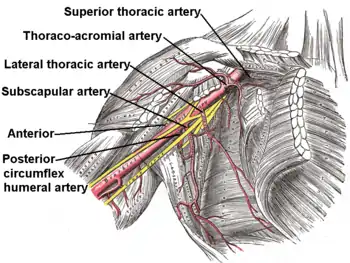Lateral thoracic artery
In human anatomy, the lateral thoracic artery (or external mammary artery) is a blood vessel that supplies oxygenated blood to the lateral structures of the thorax and breast.
| Lateral thoracic artery | |
|---|---|
 Axillary artery, with its branches, including the lateral thoracic artery. Anterior view of right upper limb and thorax. | |
| Details | |
| Source | axillary artery |
| Vein | lateral thoracic vein |
| Supplies | Serratus anterior muscle |
| Identifiers | |
| Latin | arteria thoracica lateralis |
| TA98 | A12.2.09.011 |
| TA2 | 4625 |
| FMA | 22674 |
| Anatomical terminology | |
It originates from the axillary artery and follows the lower border of the Pectoralis minor muscle to the side of the chest, supplies the Serratus anterior muscle and the Pectoralis major muscle, and sends branches across the axilla to the axillary lymph nodes and Subscapularis muscle.
It anastomoses with the internal thoracic artery, subscapular, and intercostal arteries, and with the pectoral branch of the thoracoacromial artery.
In the female it supplies an external mammary branch which turns round the free edge of the Pectoralis major and supplies the breasts.
References
![]() This article incorporates text in the public domain from page 588 of the 20th edition of Gray's Anatomy (1918)
This article incorporates text in the public domain from page 588 of the 20th edition of Gray's Anatomy (1918)
External links
- lesson3axillaryart&vein at The Anatomy Lesson by Wesley Norman (Georgetown University)